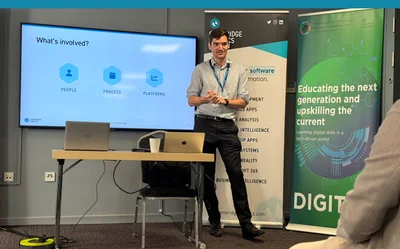
Data Without the Headache: AI-Powered Insights for Decision-Makers
How AI Reduces Complexity and Enables Smarter, Faster Decisions
Manufacturers are inundated with production metrics, quality figures, supply chain updates, sales trends and customer feedback. In theory, this abundance should lead to sharper, more informed decisions. In practice, many leaders feel overwhelmed by fragmented dashboards, outdated spreadsheets, and time-consuming analytics. They’re drowning in data but starved of insight.
AI-powered analytics changes that equation. It automates the heavy lifting (data preparation, pattern detection, anomaly spotting) and surfaces what matters in plain language so teams can act faster with more confidence. This article explores how AI transforms raw data into practical decisions via augmented analytics, real-time monitoring, and predictive intelligence, empowering teams at every level with less effort.
From Data Chaos to Intelligent Clarity
Manufacturing systems, from shop-floor sensors to ERP and CRM, generate thousands of data points every hour. Yet many senior managers still rely on weekly or monthly reports, long after key decisions should have been taken.
Why the gap? Traditional data analysis is cumbersome: extract, clean, format, analyse, interpret, often without a dedicated data team. Even business intelligence (BI) tools can require advanced skills, discouraging frontline and mid-level managers.
Some common challenges include:
- Data silos: Sales, production, and finance live in separate systems; stitching a full picture takes time.
- Complex BI tools: Dashboards can feel intimidating or time-consuming for non-specialists.
- Information overload: Too many metrics, not enough prioritisation. What matters now?
The result is gut instinct and backward-looking decisions, risky in fast markets. McKinsey found that data-driven companies are up to 19 times more profitable and 23 times more likely to acquire customers than their less data-savvy peers.
Augmented Analytics: Let AI Do the Heavy Lifting
Kinabase brings augmented analytics to the shop-floor first, centralising operational data and surfacing plain-English insights and clear visuals so teams can act faster without specialist skills.
Turn emails into action, automatically. Forward or log emails into Kinabase and they become Activities; Kinabase’s AI can then suggest and create the right follow-up tasks, turning inbox noise into a prioritised to-do list tied to the right record. You can also automate outbound emails, for example sending confirmations, delivery notes or reminders, as part of a workflow.
Why this matters:
- Buyers: see risks earlier (late suppliers, low stock) and trigger the next best step directly from the alert - to raise a PO, notify suppliers, or create tasks.
- Line Managers: receive clean, actionable queues (e.g. maintenance, quality checks) created from Activities like emails, calls or notes and assigned to the right person.
- Planners: get dynamic priorities, not more tasks. Alerts surface only when schedules, orders or capacities change, with one-click actions to update plans.
- Leaders: spend time on decisions, not deck-building for dashboards to stay current and narrative insights explain the “why” behind the metrics.
Augmented analytics across the ecosystem
Augmented analytics more broadly uses AI-powered platforms to assist with data preparation, insight generation, and explanation, lowering the skills barrier and speeding time-to-answer. Instead of asking people to join spreadsheets and run models, augmented platforms continuously monitor data and flag what’s important (e.g. rising defect rates correlated with shop-floor temperature) so that the right data reaches the right owners at the right time.
Modern platforms now embed these capabilities:
- Kinabase: built for smarter analysis, with AI-powered filters for instant insight, AI task suggestions that turn findings into action, and AI-driven dashboards that visualise trends effortlessly - keeping the loop from data to decision short.
- Microsoft Power BI: automated Insights, anomaly detection and Copilot for natural-language analysis and narrative support.
- Qlik: Insight Advisor auto-generates visuals and supports natural-language questions.
- Tableau: Ask Data has been retired (Cloud Feb / Server 2024.2); customers are being directed to Tableau AI / Tableau Pulse for improved NLQ and proactive insights.
This capability changes how decisions get made. Rather than spending hours building reports, leaders can focus on interpreting insights and taking actions. Momentum is clear: Gartner (June 2025) predicts that half of business decisions will be augmented or automated by AI agents.
Real-Time and Predictive Insights
End-of-month reports are too slow. With AI-enhanced analytics, signals are interpreted as they happen. Imagine a tablet alert: “Cycle time on Machine 5 has dropped 10% in the last hour – possible impact: 50 units behind schedule”. Rather than wait for someone to notice at shift end, action can be taken immediately. This shift from reactive to proactive management is one of AI’s most powerful contributions.
AI also looks ahead with predictive insights. Based on order history, production rates, and supply chain variability, AI might warn: “Stockout risk for Component B in 7 days – delivery lag exceeds buffer”. That foresight helps teams act before problems escalate. Scenario planning then explores “What if we add a shift?” or “What if demand drops 15%?” to quantify outcomes.
The evidence is strong:
AI-driven forecasting can reduce errors by 20-50%, cut lost-sales risk by up to 65%, and lower warehousing costs by 5-10% (with administration costs down 25-40% in some contexts).
Smarter Decisions at Entry Level
The biggest impact often lands with supervisors, engineers and planners:
- Line Managers get real-time quality alerts and adjust parameters on the spot.
- Buyers see supplier reliability trending down and reroute orders proactively.
- Planners rebalance schedules with predictive delivery times.
This spreads intelligence across the organisation and strengthens a data-first culture where debates move from “Which number is right?” to “What will we do?”.
Wider industry research also underscores the execution gap: Wipro’s 2025 Data4AI report highlights data readiness as a prerequisite for scaling AI, linking improved data foundations to faster decision cycles. Instead of meetings debating numbers, teams now discuss actions because the data is clear and trusted.
Human Context Still Matters
AI spots patterns humans miss, but context remains essential. An AI might flag a spike in energy use, unaware it’s due to a one-time event like a power test. A supervisor therefore can dismiss the anomaly. Used well, AI improves situational awareness, and in manufacturing, seemingly small gains (e.g. 2% less scrap, 5% higher output) compound into major savings over the year.
According to McKinsey, manufacturers who use AI-led analytics can reduce conversion costs by 10-15% and cut inventory levels by up to 50%. Those kinds of efficiencies drive real business value.
From Insight to Action
Ultimately, AI-powered analytics gives manufacturers the clarity they’ve long needed. It transforms data from a source of frustration into a source of competitive advantage.
For manufacturers that have already digitised their processes, implementing AI analytics is the natural next step. It’s about making decisions faster, with more confidence, and with less manual effort.
With AI surfacing the right signals and humans making the right choices, data finally becomes what it was always meant to be: a tool for better business.
However, it is crucial to implement 'Digital Guardrails' - these ensure role-based access, traceability, and governance - always keeping a human-in-the-loop for critical automated actions helps monitor outputs for drift and bias. Gartner flags these governance risks (e.g. synthetic-data management) as a rising failure mode - we treat these as first-class requirements.
The Bottom Line
AI-powered analytics transforms data from a source of frustration into a scalable advantage.
With AI surfacing the right signals and humans applying context, decisions get faster, clearer and measurably better, without asking busy teams to become data scientists.
Schedule a free demo of Kinabase today and see how you can have AI-powered insights.
Sources
- McKinsey — Five facts: How customer analytics boosts corporate performance (2013). https://www.mckinsey.com/capabilities/growth-marketing-and-sales/our-insights/five-facts-how-customer-analytics-boosts-corporate-performance
- Gartner Glossary — Augmented analytics (definition). https://www.gartner.com/en/information-technology/glossary/augmented-analytics
- Microsoft Learn — Overview of Copilot for Power BI (updated Oct 2025). https://learn.microsoft.com/en-us/power-bi/create-reports/copilot-introduction
- Microsoft Learn — Copilot in Power BI tutorial (capabilities & experiences). https://learn.microsoft.com/en-us/power-bi/create-reports/tutorial-copilot-power-bi-introduction
- Qlik Help — Using natural language with Insight Advisor (product docs). https://help.qlik.com/en-US/cloud-services/Subsystems/Hub/Content/Sense_Hub/Insights/insight-advisor-natural-language.htm
- Tableau Help — Ask Data retirement; move to Tableau AI / Tableau Pulse (Cloud Feb 2024 / Server 2024.2). https://help.tableau.com/current/pro/desktop//en-us/ask_data_enable.htm
Recent Articles

Customising Your Digital System for Long-Term Growth
Utilising the flexibility of Kinabase to track and evolve with business needs.

From AI Risk to Resilience - an SMEs guide to Practical Governance
Learn how SMEs can align with ISO 23894 to manage AI risks, protect data, and build lasting business resilience.

Driving Businesses Forward Through Digital Transformation
Lessons from the Cambridgeshire Chamber of Commerce Event